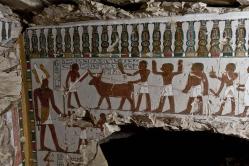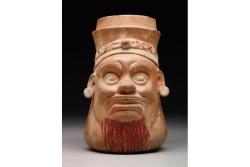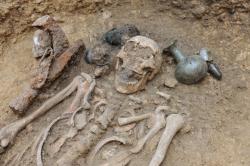INSTITUT SUPERIEUR D'ANTHROPOLOGIE
INSTITUTE OF ANTHROPOLOGY
ONLINE COURSES / COURS A DISTANCE
SPRING TERM : APRIL 2015
REGISTER NOW
EGYPTE –  Qurna - A new Ancient Egyptian tomb in the Qurna area in Luxor was discovered by an Egyptian team of archaeologists working with the American Research Centre in Egypt. Minister of Antiquities Mamdouh El-Damaty announced that the tomb contains the monuments of Amenhotep and his wife, who likely belong to the 18th dynasty. Moreover, he declared that the walls of the T-shaped tomb showcase several inscriptions. The distinctive carvings colourfully display the couple in front of a sacrifice table and during several routine rituals, such as hunting and farming. Meanwhile, the Supreme Council for Antiquities’ General Manager, Sultan Eid, has confirmed that the tomb has previously been broken into and damaged. The scratched texts, especially the name of the god “Amon”, suggest that it was disrupted during the religious revolution under the rule of revolutionary Pharaoh Akhenaton.
Qurna - A new Ancient Egyptian tomb in the Qurna area in Luxor was discovered by an Egyptian team of archaeologists working with the American Research Centre in Egypt. Minister of Antiquities Mamdouh El-Damaty announced that the tomb contains the monuments of Amenhotep and his wife, who likely belong to the 18th dynasty. Moreover, he declared that the walls of the T-shaped tomb showcase several inscriptions. The distinctive carvings colourfully display the couple in front of a sacrifice table and during several routine rituals, such as hunting and farming. Meanwhile, the Supreme Council for Antiquities’ General Manager, Sultan Eid, has confirmed that the tomb has previously been broken into and damaged. The scratched texts, especially the name of the god “Amon”, suggest that it was disrupted during the religious revolution under the rule of revolutionary Pharaoh Akhenaton.
http://www.dailynewsegypt.com/2015/03/03/ancient-tomb-discovered-in-luxor/
GUATEMALA –  Quirigua - The Dallas Museum of Art today announced the acquisition of an artistically significant pre-Columbian Maya vessel for its Arts of the Americas collection. This Late Classic (A.D. 700–900) ceramic vase is from the site of Quirigua in Guatemala, near the border with Honduras. Small, at only seven inches high, and striking, it features a modeled face, perhaps that of a Maya god.Appearing in scholarly publications in 1913, 1916, 1935, 1943, and again in 1980 and 1988, the ceramic vessel was sold at auction in November 2014 by the St. Louis Chapter of the Archaeological Institute of America, which had acquired the object in 1912 through the St. Louis chapter’s support of field excavations by archaeologist Earl H. Morris during the Third Quirigua Expedition.
Quirigua - The Dallas Museum of Art today announced the acquisition of an artistically significant pre-Columbian Maya vessel for its Arts of the Americas collection. This Late Classic (A.D. 700–900) ceramic vase is from the site of Quirigua in Guatemala, near the border with Honduras. Small, at only seven inches high, and striking, it features a modeled face, perhaps that of a Maya god.Appearing in scholarly publications in 1913, 1916, 1935, 1943, and again in 1980 and 1988, the ceramic vessel was sold at auction in November 2014 by the St. Louis Chapter of the Archaeological Institute of America, which had acquired the object in 1912 through the St. Louis chapter’s support of field excavations by archaeologist Earl H. Morris during the Third Quirigua Expedition.
http://artdaily.com/news/76844/Dallas-Museum-of-Art-acquires-a-masterwork-of-Pre-Columbian-art-for-its-Arts-of-the-Americas-Collection?#.VPXm-9-uM8o
FRANCE –  Evrecy - C'est lors d'un sondage préalable à la construction d'un lotissement à Évrecy que des traces anciennes ont été détectées il y a deux ans. Des fouilles archéologiques menées par l'Inrap (Institut national de recherches archéologiques préventives) ont permis de mettre à jour une nécropole complète et jamais inventoriée. L'ensemble funéraire conservé dans un état exceptionnel comprend 397 tombes et a été daté du milieu du IVe à la fin du VIIe siècle. Les fouilles se sont étalées de mars à juillet 2014. Actuellement, tous les ossements et objets découverts sont à l'étude en laboratoire.
Evrecy - C'est lors d'un sondage préalable à la construction d'un lotissement à Évrecy que des traces anciennes ont été détectées il y a deux ans. Des fouilles archéologiques menées par l'Inrap (Institut national de recherches archéologiques préventives) ont permis de mettre à jour une nécropole complète et jamais inventoriée. L'ensemble funéraire conservé dans un état exceptionnel comprend 397 tombes et a été daté du milieu du IVe à la fin du VIIe siècle. Les fouilles se sont étalées de mars à juillet 2014. Actuellement, tous les ossements et objets découverts sont à l'étude en laboratoire.
VIDEO= http://www.ouest-france.fr/necropole-devrecy-une-decouverte-aux-journees-de-larcheologie-st-lo-3208038
INDE – Chandrawati - An archaeological excavation team at Chandrawati has discovered another fort here in the outskirts of Abu Road. This fort is much bigger than the previous one and is protected on the east by a hillock which was found to be a watch tower. At the entrance of the fort was found an inscription from the 12th century with depiction of a cow and a calf, perhaps denoting donation. The epigraphic evidences housed in Mt Abu museum and other places reveal that Chandravati was the capital township of Parmar kings of Abu branch. Therefore, it is likely that this fort may belong to the Parmar kings. "The newly found fort is rectangular in shape on oriented north south and was measured 200mx110m. It has been strengthened by making several bastions and buttresses, which are round, square and pentagonal on plan," said Prof Jeevan Singh Kharakwal, director of the Chandrawati project. This fort is located about 70 metres to the east of the previous one and has an entrance on its western arm. The western and southern arms are stronger compared to the eastern one. There is a very strong building inside the fort, a small part of which is exposed. It has survived up to a height of about 4 metres.
There are remains of a step well located in the north western corner of the fort. It was perhaps a source of water for the king and his officers living inside the fort. "So far three cultural phases have been identified in the main mound of Chandrawati. Among these, the first one appears to belong to 6th to 8th century AD, the second one between 9th and 10th century and the third one ranging from 11th to 15th century. These cultural periods have been identified on the basis of pottery and other minor objects. "Altogether 7.50m thick cultural deposit has been discovered so far," Kharakwal said. The excavation is a joint collaboration of Rajasthan Vidyapeeth University and Department of Archaeology and Museums and the digging work in the second season too has come to an end. "A large variety of objects such as terracotta figurines like horses, bulls, elephants, camels, bangles of glass, beads of semi precious stone, lack and glass, a variety of metal objects, remains of glass bottles have been discovered. "The intensive survey of the settlement of the site has revealed that the artisans were living on the southern margins of the township. On the western and south eastern area were discovered remains of about three dozen temples mostly raised on very high platform of bricks," said Dr. Vineet Godhal, the excavation officer from Department of Archaeology and Museums. The excavators are interested to understand the town planning besides the major function of the township. Scientists have discovered a variety of cereals people were growing at Chandrawati about a 1,000 years ago.
http://timesofindia.indiatimes.com/city/jaipur/Another-fort-of-Parmar-dynasty-found-at-Chandrawati/articleshow/46439890.cms
USA –  Hampton Plantation - A weeklong volunteer archaeological dig is underway at the Hampton Plantation State Historic Site on the Santee River between Charleston and Georgetown.The excavation, which began Monday, focuses on uncovering what is thought to be the brick foundation of old slave cabin on the one-time rice plantation.
Hampton Plantation - A weeklong volunteer archaeological dig is underway at the Hampton Plantation State Historic Site on the Santee River between Charleston and Georgetown.The excavation, which began Monday, focuses on uncovering what is thought to be the brick foundation of old slave cabin on the one-time rice plantation.
The main attraction at the site is the large white plantation house owned by five generations of the Horry-Rutledge family from the 18th century until 1971 when the state acquired the property.Archaeologists along with volunteers spent Monday excavating part of a slave quarters that was discovered on the property years ago. Under blue skies and among the pine trees in McClellanville, archaeologists and volunteers hard at work chipping away at a piece of history. But there are still many questions to be answered which is where Stacey Young, the site archaeologist, comes in. “Our first goal was to expose the entire foundation of the house to get an idea of how big it was, how it was constructed. So now we are starting to work on the interior of the house,” said Archaeologist Stacey Young. “We were trying to see was there any evidence of a central partition or any difference in the things that they had. All the dirt that we excavate from the units we screen it and basically anything that we find that doesn't fall through we collect, so I'm sifting the dirt, picking up the artifacts that are in there. Everything will get bagged up and we will take it back to lab and wash it and then do further analysis.” So far the crew has found a wide range of items. “Broken plates and bowls that the slaves were using, different size nails. This is kind of cool they just found a thimble over here,” said Young.
The team will finish up this week and left in its place will be a sign helping visitors to the Plantation visualize what stood here in the 18th century.
http://www.abcnews4.com/story/28234773/archaeological-dig-this-week-at-state-historic-site
FRANCE – Cahors - Laurent Guyard, le directeur de la cellule archéologique du département du Lot l'affirme : «Le centre ancien de Cahors recèle encore un volume de vestiges à découvrir». Sous les pavés, des siècles d'occupation humaine depuis les Romains dorment en secret, et il faut les sondages des archéologues pour faire ressurgir une infime parcelle de ce passé. La conférence organisée mardi soir par le service du patrimoine de la ville a donné l'occasion à Laurent Guyard, de donner la lecture des campagnes de fouilles réalisées en 2014. Ces opérations, études ou diagnostics, ont précédé des chantiers de construction ou de rénovation. Face à la médiathèque, la tranchée creusée sur plusieurs dizaines de mètres de longueur dans ce qui était l'ancienne plaine alluviale de Cahors, a fourni une indication précieuse aux archéologues : «À partir des poteries trouvées, on peut vieillir l'occupation de la ville jusqu'au Bronze final à — 850 avant notre ère» précise Laurent Guyard. Dans le même secteur, la découverte du mur de l'aire de chauffe de l'ancien four de tuilier a confirmé l'implantation d'un atelier du temps des Romains. Plus émouvant, ces restes de tuiles estampillées du nom du fabricant local, le citoyen Titus Liberius, qui diversifiait ses activités en produisant des colonnes en pièces détachées. Sur les vestiges mis au jour, les archéologues forgent leurs convictions comme celle de la présence d'entrepôts près du port de Divona au bord du Lot ou celle d'un hypothétique sanctuaire sous la médiathèque. Place de la Citadelle au nord des fortifications, à l'emplacement de la «Porte del Duc», une coupe de près de 2 m de profondeur a fait émerger la rue du Moyen-Âge. Le bitume de l'époque se composait d'un agrégat de déchets, débris de murs et morceaux de poteries. Place François-Mitterrand, avant que les ouvriers entament le montage de la pergola, les archéologues sont allés scruter le sous-sol. Le passé affleure, à 1,20 m de profondeur, des murs médiévaux sont apparus. Le Moyen-Âge a fait de nouveau son apparition place Champollion où avant d'attaquer le réaménagement du site, l'État avait prescrit un diagnostic préventif confié à la cellule départementale d'archéologie. Les trois seuls sondages opérés sur les lieux ont fini de convaincre les scientifiques qu'il y avait là, sous leurs pieds, peut-être tout un quartier du XIIIe siècle qu'on avait oublié. Les signes et les restes repérés dans le sous-sol avec notamment une terre étonnamment fine et meuble, prouveraient, selon Laurent Guyard, que le jardin de l'Évêque s'étendait depuis la place Champollion actuelle jusqu'à la Daurade. «Ce jardin, note le chercheur, a fossilisé tout un quartier». Pas de statue romaine ou de mosaïque dévoilées, le Cahors antique percé par les archéologues est celui d'une cité qui travaillait et prospérait. Un passé retrouvé finalement proche de nous.
http://www.ladepeche.fr/article/2015/02/26/2056407-vestiges-la-ville-revele-ses-dessous-archeologiques.html
ROYAUME UNI –  Aghagallon - Archeologists are probing a Neolithic henge in the middle of Aghagallon which they believe dates back more than 4,500 years. It the reason why Aghagallon has its name and now the Standing Stone is to be given its proper place in history. Aghagallon, translated from Gaelic means Field of the Standing Stone, and it was just a few years ago that its true significance was uncovered when they discovered the giant ringed site. For many years it was unclear where this standing stone might be, however when the local community association made plans to extend its building on the Aghalee Road, it was discovered that they were right beside the standing stone.The ringed site which is in the townland of Derrynaseer was designated as a scheduled historic momunent in 2003. It is formed by a large earthen bank which encloses a domed area some 180m in diameter and is clearly visible on Google Earth. Archeologists from the Northern Ireland Environment Agency have been on-site recently and are carrying out non-invasive investigations to try and discover what lies beneath this historic site.
Aghagallon - Archeologists are probing a Neolithic henge in the middle of Aghagallon which they believe dates back more than 4,500 years. It the reason why Aghagallon has its name and now the Standing Stone is to be given its proper place in history. Aghagallon, translated from Gaelic means Field of the Standing Stone, and it was just a few years ago that its true significance was uncovered when they discovered the giant ringed site. For many years it was unclear where this standing stone might be, however when the local community association made plans to extend its building on the Aghalee Road, it was discovered that they were right beside the standing stone.The ringed site which is in the townland of Derrynaseer was designated as a scheduled historic momunent in 2003. It is formed by a large earthen bank which encloses a domed area some 180m in diameter and is clearly visible on Google Earth. Archeologists from the Northern Ireland Environment Agency have been on-site recently and are carrying out non-invasive investigations to try and discover what lies beneath this historic site.
http://www.lurganmail.co.uk/news/local-news/huge-ringed-fort-is-thought-to-date-back-4-500-years-to-neolithic-times-and-is-one-of-only-eight-left-in-northern-ireland-1-6601818
IRLANDE –  Croagh Patrick - A cow may have unwittingly revealed ancient artwork not seen for millennia after dislodging stones beside the prehistoric Boheh Stone, known locally as the St Patrick’s Chair, along the Tóchar Phádraig pilgrimage route.The prehistoric engravings are believed to be one of only two of their kind west of the Shannon. They were discovered by two Connemara archaeologists, Michael Gibbons and Michael Moylan, during field work.The panel, which bears spiral engravings believed to be 6,000 years old, is located in the townland of Boheh, outside Westport on the Leenane road. The artwork is stylistically related to the art from the passage tombs in the Boyne Valley, and the only other similar art work west of the Shannon is located in the mountains above Tourmakeady.
Croagh Patrick - A cow may have unwittingly revealed ancient artwork not seen for millennia after dislodging stones beside the prehistoric Boheh Stone, known locally as the St Patrick’s Chair, along the Tóchar Phádraig pilgrimage route.The prehistoric engravings are believed to be one of only two of their kind west of the Shannon. They were discovered by two Connemara archaeologists, Michael Gibbons and Michael Moylan, during field work.The panel, which bears spiral engravings believed to be 6,000 years old, is located in the townland of Boheh, outside Westport on the Leenane road. The artwork is stylistically related to the art from the passage tombs in the Boyne Valley, and the only other similar art work west of the Shannon is located in the mountains above Tourmakeady.
http://www.mayonews.ie/index.php?option=com_content&view=article&id=21532%3Ahugely-important-prehistoric-rock-art-found-near-croagh-patrick&catid=23%3Anews&Itemid=46